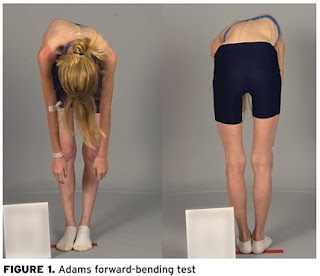Recently, some people asked me, "Is scoliosis inherited?"
Is it one of the Murphy's Law? (<- Do you remmember?)
Often one asked me a thing another one ask me same thing, and few more people follow them.
Anyway, I explain about scoliosis as Q&A style today.
Q. What is the scoliosis?
A. Scoliosis is a medical condition in which a person's spine is curved from side to side. Although it is a complex three-dimensional deformity on an X-ray, viewed from the rear, the spine of an individual with scoliosis may look more like an "S" or a "C" than straight line. (by wikipedia)
Q. Does scoliosis infect?
A. No.
Q. What is the cause of scoliosis?
A. Today, most of cases of causes are unknown.
However there are categorized as below:
Idiopathic 65%
Congenital 15%
Secondary to a neuromusculr disease 10%
I. Malfunctional scoliosis (temporary)
Due to mal-posture, inequality of legs in length, sciatica
II. Structural scoliosis (illness)
1. congenital
2. neuromuscular
3. neurofibroma
4. mesenchymal
5. traumatic
6. other causes
7. idiopathic
infant (onset at 0~3 years old)
school-age (onset at 4~10 years old)
adolescent (onset at after 10 years old)
Q: What age does scoliosis onset mostly?
A: Most case of scoliosis are adolescent. In general, it onsets around 10 to 15 years old.
Q: Does scoliosis cause to abnormality of nervous system?
A: Yes or No.
Neuromuscular scoliosis affects to nervous system, but most cases of idiopathic scoliosis do not affect to.
Q: How are the ratio in-between men and women?
A: Number of women patients is 5 to 7 times more than men patients.
Q: Is there any method to prevent scoliosis?
A: Not found yet.
Q: Does scoliosis spontaneously recovered?
A: Only infant scoliosis has been acknowledged.
Q: Any relation to the occurrence of the scoliosis and weight of a bag or how to hold it?
A: Often people talk about that, but answer is NO.
Q: Keeping good posture prevents progression of scoliosis or heals it?
A: Keeping good posture is very important in general, but that cannot prevent progression of scoliosis.
Q: Taking enough calcium prevents scoliosis?
A: Taking calcium is very important to growth of bone and to prevent osteoporosis, but cannot prevent occurrence of scoliosis.
Q: After grown, does scoliosis still progress?
A: In general, scoliosis does not progress after grown other than neurofibroma and neuromuscular.
However the scoliosis with high degree curve may progress little by little after grown.
Q: What will be happened if a scoliosis have not taken care and became high degree?
A: High degree scoliosis induces deformation of thoracic, and then lung function will be lowered.
Eventually, lung and heart will have serious complications.
Q: Is scoliosis inherited?
A: Today, there is NO clear answer.
However, the relevancy may be found in the future.
Q: Can idiopathic scoliosis be cured by therapeutic exercise?
A: Today, no objective data has reported as, “therapeutic exercise is effective”.
Manual correction is not effective either.
Q: Will a scoliosis be high degree if it is uncared?
A: Not always.
There are so much individual differences.
In general, the scoliosis more tend to progress if it occurred in young age.
Q: Does Acupuncture work for scoliosis?
A: Yes, there are many successful case studies of scoliosis by acupuncture.
And the practices start younger make better results in general.
I collect many of information in above Q & A from Japanese material.
So some (many) translate difficulty were there (as always (१▽१*)).
If you have more questions or questions for my English, please contact me.
X-rays of Scoliosis
I am taking a data of pectus excavatum (funnel chest) with my model patient.
It is really tough more than scoliosis.
But so far, the situation is getting better (at least better than nothing).
I hope I can report this one-day.
(゚∀^*)d !




I'm not sure how many of you are aware of the recent scientific developments and breakthroughs that have or are recently occurring in the field of scoliosis treatment. Prognostic testing/technology in the way of genetic testing and blood tests are now able to determine which early stage scoliosis patients are most likely to experience severe curve progression. This presents a new and unique opportunity for early stage scoliosis intervention rehab programs to reduce and eliminate many of the "at risk" smaller curve cases before they progress to much more complex and difficult large curvature cases. It’s actually quite revolutionary and amazing.
ReplyDelete